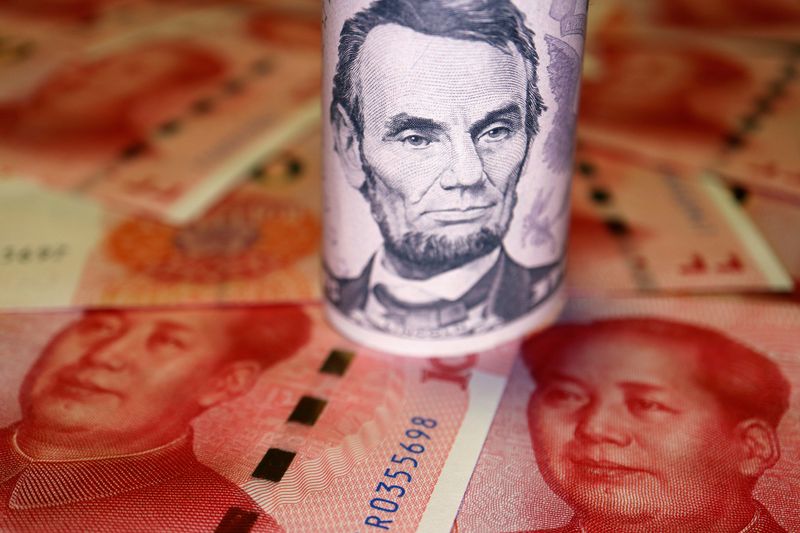Forex
Dollar set for fifth straight week of gains as China stays top of mind


© Reuters. FILE PHOTO: U.S. Dollar and Chinese Yuan banknotes are seen in this illustration picture taken June 14, 2022. REUTERS/Florence Lo/Illustration
By Hannah Lang
WASHINGTON (Reuters) – The dollar was flat on Friday but set for a fifth consecutive week of gains in its longest winning streak for 15 months, buoyed by demand for safer assets on worries over China’s economy and bets that U.S. interest rates will stay high.
The People’s Bank of China (PBOC) set a much stronger-than-expected daily fixing, lifting the yuan from a 9-month low hit on Thursday.
The yuan weakened against the dollar to 7.3060 in offshore trading after the PBOC set the official mid-point at 7.2006, more than 1,000 pips stronger than Reuters’ estimate.
China’s economic troubles have deepened, with property developer China Evergrande (HK:) seeking Chapter 15 protection in a U.S. bankruptcy court. Concerns are also growing over default risks in its shadow banking sector.
The , which measures the currency against six peers, edged 0.01% lower at 103.380, after touching a new two-month high of 103.680 earlier in the session. For the week, it is set to gain 0.5%.
“The dollar continues to string together this rally,” said Joe Manimbo, senior market analyst, at Convera. “With the U.S. economy holding up much better than expected, it’s leading the market to push out the timeframe for when the Fed is likely to ease.”
Minutes from the Federal Reserve’s last meeting showed this week that most members of the rate-setting committee continued to see “significant upside risks to inflation”. Strong economic data this week, particularly retail sales, also bolstered the case for additional tightening.
The dollar also saw a boost as investors appeared concerned that Chinese authorities hadn’t done enough to shore up the economy.
The PBOC cut rates earlier this week in a surprise move that widened the yield gap against the U.S., rendering the yuan even more vulnerable to decline.
“People are getting a little concerned with some of the statistics we’ve seen out of China,” said Joseph Trevisani, senior analyst at FXStreet.com.
“When you get a sector that appears to be as overextended as the Chinese property sector, especially the retail and commercial sector, that really has a drag on the economy,” he said.
INTERVENTION RISK
The depreciation of the yen kept traders on edge against the risk of intervention by Japanese authorities.
The Japanese yen strengthened 0.38% versus the greenback at 145.29 per dollar after reaching a nine-month low of 146.56 on Thursday.
“When things go south in China, traditionally or historically there’s been a move into the yen, which would strengthen the yen, but that’s not been the case this time,” said Trevisani.
In autumn of last year, the dollar’s surge beyond 145 triggered the first yen buying intervention from Japanese authorities in a generation.
The Australian dollar, which often trades as a proxy for China, rose 0.04% to $0.640, after hitting a nine-month low of $0.6365 on Thursday.
Elsewhere, sterling fell 0.05% to $1.2741 after British retailers reported a bigger-than-expected drop in sales in July. The euro edged 0.04% higher at $1.08745, after touching on Thursday a six-week low of $1.0856.
Meanwhile, the world’s biggest cryptocurrency, bitcoin, slipped 2.33% to $26,020 after dipping to a fresh two-month low, adding to a more than 7% plunge on Thursday, as a wave of risk-off sentiment grips world markets.
“We suspect that the synchronized selloff in equities and fixed income eventually spilled over into crypto as crossover investors reduced portfolio risk,” researchers at Grayscale Investments, a crypto asset manager, wrote in a blog post.
========================================================
Currency bid prices at 3:02PM (1902 GMT)
Description RIC Last U.S. Close Pct Change YTD Pct High Bid Low Bid
Previous Change
Session
Dollar index 103.3700 103.4000 -0.01% -0.116% +103.6800 +103.2200
Euro/Dollar $1.0876 $1.0871 +0.05% +1.50% +$1.0894 +$1.0845
Dollar/Yen 145.2850 145.8350 -0.36% +10.83% +145.8700 +144.9300
Euro/Yen 158.02 158.53 -0.32% +12.63% +158.5700 +157.6700
Dollar/Swiss 0.8821 0.8785 +0.43% -4.58% +0.8825 +0.8775
Sterling/Dollar $1.2739 $1.2748 -0.05% +5.35% +$1.2765 +$1.2690
Dollar/Canadian 1.3547 1.3545 +0.01% -0.02% +1.3575 +1.3527
Aussie/Dollar $0.6404 $0.6402 +0.04% -6.04% +$0.6429 +$0.6380
Euro/Swiss 0.9593 0.9549 +0.46% -3.05% +0.9598 +0.9548
Euro/Sterling 0.8535 0.8527 +0.09% -3.49% +0.8557 +0.8527
NZ $0.5927 $0.5926 +0.03% -6.65% +$0.5947 +$0.5910
Dollar/Dollar
Dollar/Norway 10.6370 10.5880 +0.42% +8.34% +10.6740 +10.5750
Euro/Norway 11.5704 11.5037 +0.58% +10.26% +11.5932 +11.4843
Dollar/Sweden 10.9716 10.9236 +0.42% +5.42% +11.0026 +10.9023
Euro/Sweden 11.9336 11.8832 +0.42% +7.03% +11.9494 +11.8762

 Forex3 years ago
Forex3 years agoForex Today: the dollar is gaining strength amid gloomy sentiment at the start of the Fed’s week

 Forex3 years ago
Forex3 years agoUnbiased review of Pocket Option broker

 Forex3 years ago
Forex3 years agoDollar to pound sterling exchange rate today: Pound plummeted to its lowest since 1985

 Forex3 years ago
Forex3 years agoHow is the Australian dollar doing today?

 Cryptocurrency3 years ago
Cryptocurrency3 years agoWhat happened in the crypto market – current events today

 World3 years ago
World3 years agoWhy are modern video games an art form?

 Commodities3 years ago
Commodities3 years agoCopper continues to fall in price on expectations of lower demand in China

 Economy3 years ago
Economy3 years agoCrude oil tankers double in price due to EU anti-Russian sanctions


























